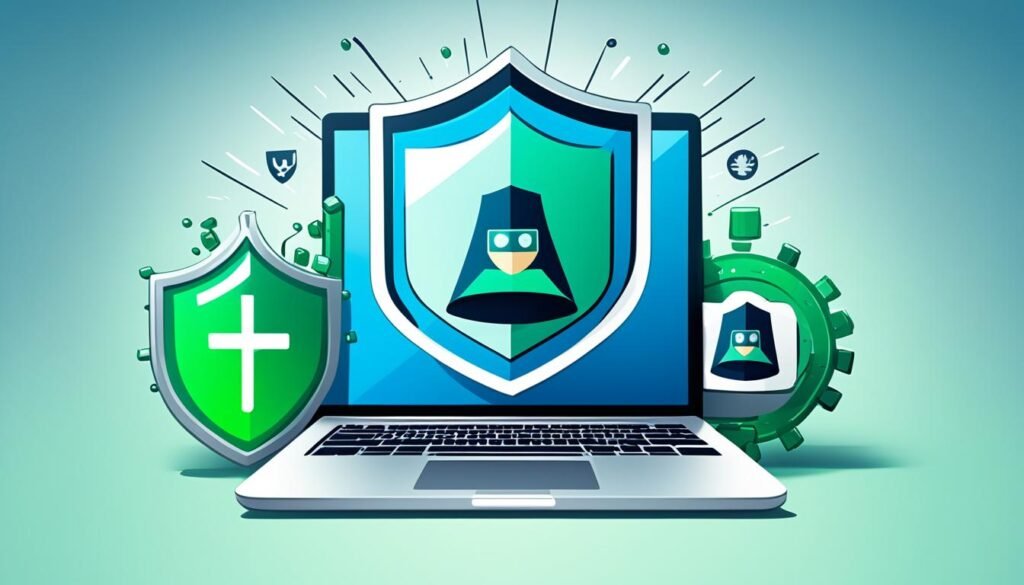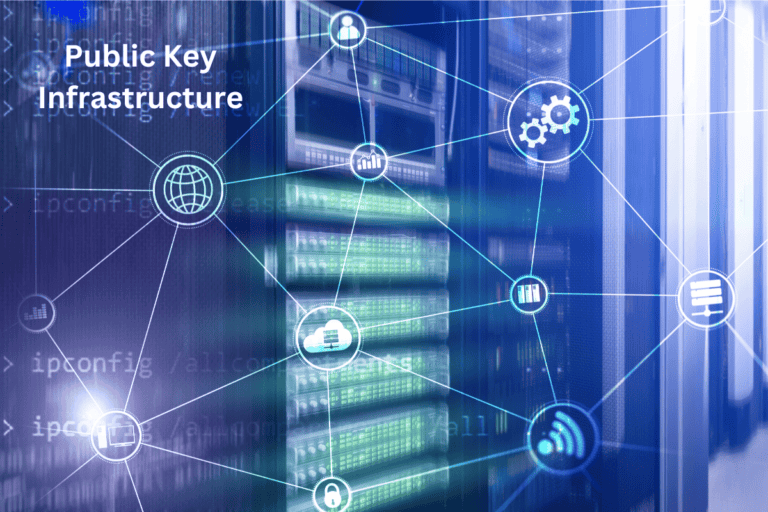What is Cybercrime and How to Prevent It?
Did you know that cyber attacks jumped by 31% from 2020 to 2021? This shows how big of a threat cybercrime is today. Now, the average company faces 270 attacks every year, up from 206 before.
A single cyber attack can cost a company about $200,000. This can push many companies out of business within six months. Identity fraud losses in 2021 reached a huge $56 billion, says Javelin Strategy & Research’s Identity Fraud Study.
Understanding cybercrime is key because of its big risks. These risks include financial losses, damage to reputation, and losing personal data. We all need to be aware of these threats and take steps to protect ourselves online.
Key Takeaways
- Security attacks rose by 31% from 2020 to 2021.
- Companies face an average of 270 attacks per year, up from 206.
- A single cyber attack costs companies an average of $200,000.
- Identity fraud losses totaled $56 billion in 2021.
- Both individuals and organizations are at risk of cybercrime.
- Implementing strong online security measures is essential.
Understanding Cybercrime in the Digital Age
The digital world is a big part of our lives today, but it also brings risks like cybercrime. Cybercrime includes stealing identities, fraud, and data breaches. These crimes are more common because we use more devices and cloud apps.
Now, we rely more on the internet, which makes our info more at risk. Social engineering is a big threat that tricks people into sharing secrets. It uses emotions to break trust and get information. Knowing how it works is key to staying safe online.
Big cyber attacks like WannaCry in 2017 and SolarWinds in 2020 show how fast threats change. They highlight the need for strong security to protect important systems. Experts say cybercrime could cost $10.5 trillion a year by 2025. As we use more digital tools, the risks grow too.
Studies show threats can come from inside or outside. Planning for cyber security helps fight off false threats. We must keep up with threats like insider attacks, supply chain hacks, and phishing to keep data safe.
Data breaches are a big worry, aiming at personal and financial info. IBM’s 2023 report says a data breach now costs about $4.45 million. The healthcare sector faces the biggest costs from cyber attacks, showing the need for strong security.
To fight cyber threats, we must understand the risks and how to defend against them. Cybersecurity helps protect our digital world from hackers and attacks. It keeps our online identities and data safe in the digital age.
Common Types of Cyber Threats
In today’s digital world, cyber attacks are a constant threat. They come in many forms, like malware, phishing, ransomware, and hacking. Each type targets different weaknesses, needing unique ways to fight back.
Malware
Malware is a top cyber threat, covering viruses, worms, and more. It aims to steal or damage data. To fight it, use strong passwords, email security, and antivirus software.
Phishing
Phishing tricks people into sharing sensitive info through fake emails or messages. It’s a big problem. Using email security and teaching people about it can help stop phishing.
Ransomware
Ransomware locks your data and demands money to unlock it. It’s a big threat for money and can slow down businesses. To fight it, use top-notch threat detection and quick response plans.
Hacking
Hacking means getting into a system without permission. It’s often for stealing data or causing trouble. Ethical hackers help find and fix security holes. Companies use firewalls and other tools to protect against hackers.
| Type of Cyber Threat | Description | Common Defenses |
|---|---|---|
| Malware | Viruses, worms, trojans, and other malicious software designed to steal or corrupt data. | Antivirus software, strong passwords, email security tools. |
| Phishing | Deceptive activities to trick individuals into revealing personal information. | Email security tools, user education. |
| Ransomware | Malware that encrypts data and demands ransom for decryption. | Advanced threat detection, incident response capabilities. |
| Hacking | Unauthorized access to systems for data theft or disruption. | Firewalls, VPNs, multi-factor authentication, endpoint security solutions. |
Importance of Cybersecurity Awareness
In today’s world, cybersecurity awareness is key for everyone. It’s vital to know how to protect your personal info and avoid financial loss. Let’s look at why knowing about cybersecurity is so important.
Protecting Personal Information
Keeping your personal info safe is a big reason to focus on cybersecurity awareness. In 2021, over 5.7 million cybercrime reports were filed, with identity theft making up 25% of them. Hackers use phishing and social engineering to get your personal data. By learning how to spot these threats, you can lower the chance of identity theft.
Avoiding Financial Loss
Preventing financial loss is another big reason for cybersecurity awareness. In 2022, the average cost of a data breach was $4.35 million. Most cyber threats start with emails, causing 94% of ransomware and malware. Teaching people how to spot phishing scams can help avoid financial losses and keep transactions safe.
Preventing Cyber Attacks
Cyber attacks are on the rise, with ransomware attacks going up by 48% in 2020. Every day, 300,000 new malware pieces are made. Most data breaches happen because of human mistakes, showing how important cybersecurity awareness programs are. By teaching users about threats, companies can better defend against cyber attacks and bounce back faster.
“The human element continues to be both a significant risk and a vital line of defense in cybersecurity.” – Verizon’s 2022 Data Breach Investigations Report
Putting money into cybersecurity awareness helps protect your personal info and prevent financial loss. It also helps stop cyber attacks. This approach builds a culture that values security, keeping your data and assets safe online.
How to Recognize and Avoid Phishing Scams
Phishing scams are a big problem, with thousands happening every day. They often come as emails that look like they’re from trusted places like banks or government agencies. These emails might say something urgent, like “Immediate attention required,” and ask for your private info.
To spot phishing scams, check if emails asking for sensitive info are real. These emails might lead you to fake websites that look real. They ask you to give out personal details like your Social Security number and passwords.
Never give out personal info online or over the phone unless you’re sure it’s safe. If you think you’ve fallen for a scam, call your bank right away. Also, put fraud alerts on your credit reports. Here are the numbers for the big credit agencies:
- Equifax: 800-525-6285
- Experian: 888-397-3742
- TransUnion: 800-680-7289
Phishing scams can cause big problems, like identity theft. So, report any weird contacts to the Federal Trade Commission at 1-877-IDTHEFT. Using good online security measures helps too. Make sure your security software is up to date, use more than one way to log in, and back up your data.
Verizon says 96% of phishing attacks come through email, so be careful with emails and texts. Always check if they’re real before you click on links or open attachments. Being careful and proactive is the best way to keep safe from phishing scams and protect your online security.
Best Practices for Online Security
To make your online security better, following best practices is key. These steps greatly lower the chance of cyber threats and data breaches.
Use Strong Passwords
Creating strong passwords is crucial for online safety. Since 80% of data breaches happen because of weak or stolen passwords, using unique, complex passwords helps. Mix upper and lower case letters, numbers, and special characters to make strong passwords.
Enable Two-Factor Authentication
Two-factor authentication (TFA) adds an extra layer of safety. It requires a second verification, like a code on your phone. This cuts the risk of unauthorized access by up to 50%. With strong passwords and TFA, your account stays safe even if your password is leaked.
Regularly Update Software
Keeping software up to date is key to fighting cyber threats. About 60% of security breaches use unpatched software flaws. Update your operating systems and apps regularly to apply the latest security fixes. This lowers the chance of cyber-attacks that target old vulnerabilities.
Following these best practices makes online security stronger. Using strong passwords, enabling two-factor authentication, and updating software often makes it harder for hackers. This way, you and your organization can greatly reduce the risk of cyber threats.
| Cybersecurity Measure | Effectiveness |
|---|---|
| Strong Passwords | 80% of breaches involve weak passwords |
| Two-Factor Authentication | Reduces unauthorized access by 50% |
| Software Updates | 60% of breaches involve unpatched software |
Protecting Your Devices Against Malware
Cyber threats are rising fast, with more malware attacks every year. It’s vital to use strong protective steps to keep your devices and data safe. Here, we’ll look at ways to boost your malware protection.
Installing Antivirus Software
Antivirus software is your first defense against malware. It’s important to keep your antivirus updated and scan your devices for viruses every two months. Since most malware comes through email, having a good antivirus is key to stopping these threats.
Using Firewalls
Firewalls add another layer of safety, keeping unauthorized users out of your network. They watch over your network traffic and block suspicious activities. Using firewalls with antivirus software makes your system much safer.
Regular Backups
Backing up your data often is key to keeping your information safe. If malware hits, you can get your files back without paying a ransom. With ransomware attacks on the rise, backups are more important than ever for keeping your data secure.

| Technique | Purpose | Action Frequency |
|---|---|---|
| Antivirus Software | Detect and remove malware | Update regularly, scan twice a month |
| Firewalls | Block unauthorized access | Continuous monitoring |
| Data Backups | Recover data after attacks | Regular intervals |
Safeguarding Your Online Identity
In today’s digital world, keeping your online identity safe is crucial. Cybercriminals are getting smarter, so we need strong security to protect against fraud and identity theft.
Use Biometric Authentication
Biometric authentication is now a key security step. It uses things like fingerprints and facial recognition, which are hard to fake. This makes it harder for others to get into your stuff. Turning on biometric authentication on devices and accounts boosts cyber security. It makes sure only you can get in.
Manage Passwords with a Password Manager
Using password managers is a smart way to protect your online identity. These tools make strong, unique passwords for all your accounts. This lowers the chance of password theft. With a password manager, you don’t have to remember lots of passwords. It makes keeping your accounts safe easier.
The Role of Cyber Laws in Combating Cybercrime
Cyber laws are key in fighting cybercrime in our digital world. They set up strong rules to handle online wrongdoings and boost cyber security. These laws help in fighting cybercrime by setting out how to catch and punish cybercriminals. They also protect our online transactions and keep our data safe.
Many groups and organizations are key in making sure cyber laws are followed. The Department of Homeland Security (DHS) has done big investigations into cybercrime. They’ve stopped many cybercriminals. The U.S. Secret Service has also caught cybercriminals from around the world who stole millions of credit card numbers, causing losses of nearly $600 million.
The U.S. Secret Service runs the National Computer Forensic Institute. It gives cyber training to law enforcement, prosecutors, and judges. ICE’s Homeland Security Investigations (HSI) has the Cyber Crimes Center (C3). It helps both domestic and international agencies fight crimes across borders.
Worldwide, countries have their own ways to deal with cybercrime. Germany, Japan, and China have made their laws stronger against cybercrime. Australia and Senegal have laws against unauthorized data changes and wrong data handling. These laws show how different countries fight cybercrime.
Working together across borders is key to fighting cybercrime’s complex issues. For example, the U.S. Secret Service’s Electronic Crimes Task Forces track down cybercriminals from other countries. They deal with cyber attacks, bank fraud, and data breaches. The Law Enforcement Cyber Incident Reporting helps local law agencies report cyber crimes to the feds, making investigations smoother.
Cyber laws protect us from cyber threats and keep our creative work safe from copyright issues. They also shield us from identity and credit card theft. Laws from around the world, like common, civil, and religious laws, work together to keep our information safe. This helps make data sharing in companies secure.
Schools also help by teaching about cyber security laws and how cybercrime affects us. Courses like CIS 301 and ECCU 517 teach the legal side of cyber security. They prepare professionals to handle cyber laws well.
It’s important to keep making and updating cyber laws to fight cybercrime worldwide. This keeps our digital world safe and trustworthy for everyone.
Conclusion
Staying safe online requires a strong cyber security plan. With threats like Financial, Privacy, Hacking, and Cyber Terrorism, it’s key to know the risks. Financial crimes steal huge amounts from businesses and governments every year.
Privacy crimes can ruin a person’s life, leading to serious outcomes. Hacking can damage websites or destroy data, showing the need for strong defenses. Cyber terrorism now targets individuals and properties, making online threats a big worry.
The internet’s growth has led to more cyber crimes. Governments have made laws and set up cyber units in police stations. These steps, along with informed people, strong tech, and good online habits, help protect us.
Adding incident response, threat intelligence, and training for employees to cybersecurity plans is crucial. This approach helps fight new cyber threats and makes the internet safer for everyone.
Source Links
- What is cybercrime? How to protect yourself
- Types of Cyber Crime: A Guide to Prevention & Impact
- 4 Things You Can Do To Keep Yourself Cyber Safe | CISA
- The Concept of Social Engineering and Cybercrime in the Digital Age
- What Is Cybersecurity? The Realities of the Digital Age
- Understanding cybercrime
- Types of Cyberthreats | IBM
- 12 Most Common Types of Cyberattacks Today – CrowdStrike
- Know the types of cyber threats
- Cybersecurity Awareness: Definition, Importance & More | Spanning
- The Importance of Cyber Security Awareness Training
- 7 reasons why security awareness training is important in 2023
- Phishing Attack Prevention: How to Identify & Avoid Phishing Scams
- How to Recognize and Avoid Phishing Scams
- Phishing Attacks: How to Identify & Avoid Phishing Scams
- 21 Cybersecurity Tips and Best Practices for Your Business [Infographic] – TitanFile
- 12 Cybersecurity Best Practices to Prevent Cyber Attacks in 2024 | Ekran System
- Maintain Good Cybersecurity Habits | Morgan Stanley
- Protect Your Computer From Viruses, Hackers, and Spies
- How to Prevent Malware Attacks
- What is malware and how cybercriminals use it | McAfee
- Strategies to Help Protect Your Digital Footprint | Morgan Stanley
- Identity Theft and Online Security
- 10 Tips for Protecting Your Identity on the Internet
- Combatting Cyber Crime | CISA
- Cybercrime Module 3 Key Issues: The Role of Cybercrime Law
- The Role of Cyber Law in Cybersecurity | EC-Council University
- Cyber Crime Essay for Students and Children | 500 Words Essay
- Cybersecurity Threat Landscape: Conclusion
- 9.6 Conclusion







